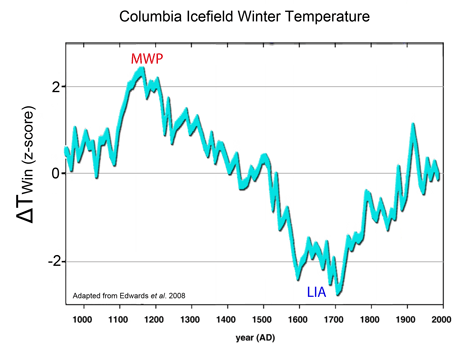Reference
Edwards, T.W.D., Birks, S.J., Luckman, B.H. and MacDonald, G.M. 2008. Climatic and hydrologic variability during the past millennium in the eastern Rocky Mountains and northern Great Plains of western Canada. Quaternary Research 70: 188-197.
Description
The authors developed a cellulose δ13C dendrochronology from cross-dated 10-year increments of 16 sub-fossil snags and living-tree ring sequences of Englemann spruce trees from upper-alpine treeline sites near Athabasca Glacier and subfossil material from the forefield of Robson Glacier plus living and snag material of whitebark pines adjacent to Bennington Glacier, spanning the period AD 951-1990, as well as an oxygen isotope (δ18O) dendrochronology pertaining to the same time period, from pairs of which data they were able to calculate past changes in temperature over Canada's Columbia Icefield in the general vicinity of 53°N, 118°W. This work produced, in their words, "evidence of previously unrecognized winter warmth during the Medieval Climate Anomaly (~AD 1100-1250)," as can be seen in the following figure.

Figure 1. Columbia Icefield mean winter temperature (Twin) relative to that of the period AD 1941-1990. Adapted from Edwards et al. (2008).




